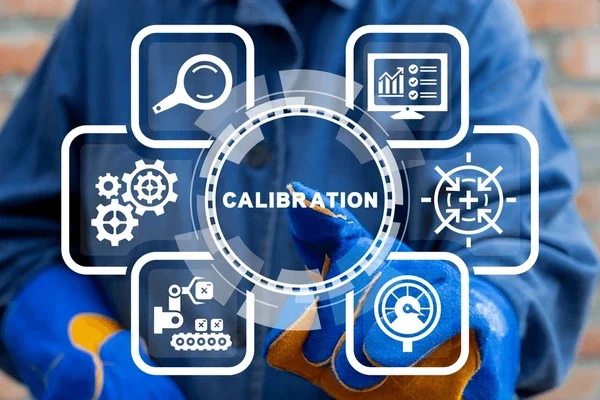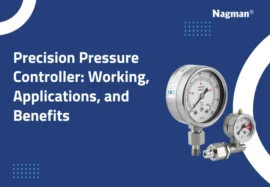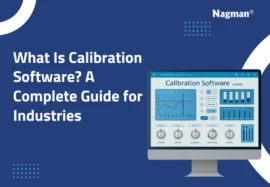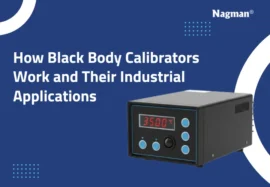Calibrating temperature ensures exact temperature control and is required in certain sectors. Accurate temperature readings are required to maintain product quality, safety, and compliance, especially in industries such as manufacturing, research, food processing, and medicine.
This blog explores the basics of temperature calibration and how Nagman’s calibration tools can support adherence.
The Importance of Temperature Calibration
Accurate temperature measurement is essential in many sectors, where even a small fluctuation can cause expensive mistakes. Calibration is the process of verifying accuracy by comparing the reading with a recognised standard.
Here’s why it’s essential:
Regulatory Compliance: Many industries must adhere to strict regulations for quality control and safety.
Product Quality Assurance: Inaccurate temperature readings can lead to defective products.
Safety Standards: Prevents overheating, spoilage, or equipment failure.
Cost Efficiency: Reduces waste and prevents rework caused by faulty measurements.
Regulatory Requirements for Temperature Calibration
Regulatory agencies enforce stringent calibration standards for several businesses, some of which are given below.
Pharmaceutical sector (FDA & GMP Guidelines)
The FDA mandates that Good Manufacturing Practices (GMP) be followed in all temperature-sensitive activities, including drug production and storage.
Even a slight deviation from the recommended temperature range may result in broken vaccines or ineffective drugs. You can regularly calibrate with the trusted Nagman Temperature Calibrator to ensure compliance.
Food and Beverage Industry (FDA & HACCP Regulations)
Temperature control affects all processes, including food manufacturing, storage, and transportation. Precise temperature calibration under Hazard Analysis and Critical Management Points (HACCP) requirements avoids contamination.
Maintain ideal conditions for cooking, cooling, and storage with a calibrated temperature sensor.
Manufacturing and Industrial Applications (ISO 9001 & ASTM Standards)
Most industries follow the ISO 9001 standards in which the production lines must have the prescribed temperature control.
The American Society for Testing and Materials, or ASTM, develops and enforces the standards for precise temperature measurement.
Medicine and Labs (CLIA & CAP Standards)
Equipment used in clinical and research labs, such as incubators and freezers, needs to be kept at the proper temperature. Groups such as the College of American Pathologists (CAP) and the Clinical Laboratory Improvement Amendments (CLIA) require regular calibration.
Medical and Laboratory Equipment (CLIA & CAP Standards)
Research laboratories must ensure that incubators, freezers, and other equipment maintain correct temperatures.
CLIA (Clinical Laboratory Improvement Amendments) and CAP (College of American Pathologists) are two organisations which set the requirements for routine calibration.
How to Choose the Right Temperature Calibrator
Look for these features in a temperature calibrator:
- Accuracy: Make sure your calibrator meets the industry standards for precision for your company’s use.
- Ease of Use: There are calibrators with digital displays or automated calibration available if needed.
- Portability: Calibrator models like the Nagman Temperature Calibrator 650H are ideal for outdoor use due to their compact size and light weight.
- Certification and Compliance: Double-check that the calibrator you choose follows the compliance requirements for your industrial use.
Choose the right calibration partner so that your company can ensure precise temperature readings while complying with industrial quality standards.
How the Nagman Temperature Calibrator Helps Meet Regulatory Standards
A calibration tool must be both accurate and reliable. The Nagman Temperature Calibrator is precise and easy to use.
Its other benefits include:
- Highly accurate for testing even temperature sensors like RTDs, thermocouples and transmitters.
- Quick response time reduces the downtime in calibration processes.
- Portable and compact models that are easy to use even in field settings.
- Meets the required industry standards for compliance.
Best Practices for Temperature Calibration Compliance
Here are some best practices for industries to follow while calibrating:
- Calibrate Regularly: Plan regular calibrations as required legally.
- Use Accredited Calibration Equipment: Choose an industrially accepted calibration instrument and read its manual before using it. For example, read the manual for the Nagman Temperature Calibrator 650H before using the 650H model.
- Provide Training Before Use: Make sure that your technicians are familiar with the process before they calibrate the instruments.
- Maintain Detailed Records: Keep thorough records of all calibration done, which also ensures audit and compliance needs are met.
Conclusion
Temperature calibration is a legal requirement, not just a guideline. Sectors like manufacturing, healthcare, food processing, and pharmaceuticals must follow strict guidelines to ensure quality, safety, and efficiency. Companies can always rely on the Nagman range to find the perfect calibrator.






